

xyrth
-
Posts
50 -
Joined
-
Last visited
Content Type
Profiles
Forums
Events
Posts posted by xyrth
-
-
3 minutes ago, Strange said:
Aren't the spheres attached to springs? So the further away the stockpile, the more energy in the springs.
Inside the container, each sphere has a spring between the sphere and the green line. Outside the container, I don't need the springs, they keep their length constant (they are fixed somewhere if it is necessary). I count the difference of potential energy from start to end (for a small angle or a big angle).
6 minutes ago, Strange said:That implies that you have got the energy associated with the springs wrong, then. If that is the difference
I try to find the mistake in my calculations with that device.
7 minutes ago, Strange said:Also, if all the spheres are being pulled to the bottom of the container by the springs, why is there any pressure on the other three walls of the container?
All walls have pressure inside the container. I calculated the work needed to rotate the lateral walls. The upper wall is fixed and the bottom wall (green) move perpendicularly to the force of pressure, so no work.
9 minutes ago, Strange said:I don't know where those numbers come from.
I gave the integrals in the drawings.
0 -
13 minutes ago, Strange said:
And are you calculating the change in energy of the other containers you move the blue out of and the white into?
The stockpile is not under pressure. I use a spring when I need it.
For the pressure
I indicate "p=" in the drawing at start only, p=0, p=0.707, etc
0 -
5 minutes ago, Strange said:
How does replacing polystyrene with spheres (however you do it) affect the energy of the container?
That is the good question ! If I move out the white parts and move in the white parts, the sum of energy is well constant. Look at the case 1, in that case, the container is filled with blue spheres, from start, to end. At the angle 45° (arounf it), the laterals walls lost -0.207, the springs lost -0.207, the green line wins 0.414 (sure function of the angle of rotation). That is the problem (or a solution...) because when I move in the blue spheres, the springs help the green line 2 times than the springs lost in potential energy. The work of the lateral walls is already compensated by the energy to move out/in.
2 minutes ago, Strange said:The stockpile of blue spheres.
The stockpile is not under pressure, there is only blue spheres inside it. I use a spring when I need it, and sure I count the potential energy of each spring.
0 -
4 minutes ago, Strange said:
Why not assume all the spheres are attracted by gravity?
Because with gravity I found the sum of the energy at 0, not here. My device is deformed like the source of gravity is on the device itself but if I put a planet on my device, the attraction will be concentric not parallel like I want: the orientation of the springs follow the orientation of the lateral walls.
5 minutes ago, Strange said:This is rather implausible.
Think "in theory".
6 minutes ago, Strange said:I still don't see where things are moving in and out of the container. And where do the extra blue spheres come from?
Have you look the animation ? I have a stockpile of blue spheres outside the container. At final the stockpile of blue spheres is empty and the stockpile of white parts is filled.
7 minutes ago, Strange said:How do you get blocks of polystyrene to change length?
My device is unstable, I need an external device to control it but that external device count all the energies in/out. That external device do the job. (We are agree it is not really polystyrene, but ok if you want to call the white parts polystyrene.)
9 minutes ago, Strange said:thought the blue shape was the container?
No. The container has 4 walls. I move out the white parts, I move in the blue spheres.
10 minutes ago, Strange said:You mean that blue rectangle to the left.
You see rectangles, but blue spheres are like a fluid (with no mass and no friction).
11 minutes ago, Strange said:How are you calculating the energy required to move these in and out of the container?
I calculated the volume by the mean difference of pressure. The volume that moves in is the same the volume that moves out. I indicate in a drawing the mean pressures.
14 minutes ago, Strange said:The springs cause these to jump from the container they are in to the other (deforming) container?
I didn't understand what you mean
14 minutes ago, Strange said:And, as you seem to be concerned with the energy in the springs, how far away is this other container?
What other container ?
9 minutes ago, swansont said:It becomes shorter. Its volume decreases. You have compressed it.
You say it stays outside, but that it's inside the container. That is not at all clear. How does the polystyrene get outside?
No I move out the white parts from the bottom, I don't compress it.
How the polystyrene get outside: an external device is necessary, that device count all the energies out/in. The sum must be at 0.
0 -
1 hour ago, swansont said:
OK, so why not just say it's some fluid?
Because I need to have the source of the attraction on the device. For that, I need to attract each sphere from the green line (bottom wall). I could take a real fluid but for what ? I don't need the force of gravity. With a real fluid there is friction, mass, and viscosity and the calculations are very complicated (compared to mine) to find the real sum of the energy.
1 hour ago, swansont said:Where are they? Their location matters
Each sphere has a spring. Each spring is attached from a sphere and the green line. I could draw some springs but there are a lot. The orientation of the springs change during the deformation and follow the orientation of the lateral walls. But all the springs have the same orientation at a time. I drew the red line to symbolized the orientation of the springs.
1 hour ago, swansont said:If the volume of the container is constant, moving in a fluid means the white polystyrene must decrease in size. How does that happen? Unless you mean something else by "moving in"
Move out the white parts? You said they stay in the container. Is this a reference to their expansion in another direction, to remain constant volume?
I move out the white parts of the polystyrene and I move in the same volume of blue spheres in the same time. The volume of container is constant at each time. Look at the animation, the white rectangles decrease their length and the white shape outside the container increases, it is the stock of the polystyrene. The blue shape outside the container, is a stockpile of blue spheres, that stockpile decreases when the device is deformed because I move in the blue spheres.
1 hour ago, swansont said:Again, what you mean by "move out" and "move in" is unclear.
I thought the animation is ok. The container is deformed. The white rectangles rotate around the purple axes, so I need to reduce their length, I move out the container the the white parts from the "bottom", you can imagine the rectangles like assembly polystyrene, and I move out small parts more and more when the device is deformed. when the rectangles rotate, some space appears between the rectangles, I need to keep the pressure inside the container so I fill the space with blue shape.
I just understand, when I said the volume of the container is constant, it is not only the container itself BUT ALSO the volume inside the container: I need to have 100% of the container filled at each time, at start 100% of polystyrene, at final 70.7% of polystyrene and 29.3% of blue spheres. Because I want pressure always between walls, the walls of the container and the walls of the rectangles. Maybe that was not clear.
1 hour ago, swansont said:So the white does not remain constant volume. How much energy does it take to compress polystyrene? Can you recover that when it expands?
I do not compress the polystyrene, I move out it perpendicularly to the screen. The polystyrene stays outside at final (look at the animation) but my stock of blue spheres is 0 at final because I move in all the spheres inside the container.
0 -
Just now, Strange said:
If the volume of the springs is zero, then they don't exist.
It is a theoretical device. If you want, imagine the device with only one layer of spheres for the depth (perpendicularly to the screen), like that the springs can be outside. Just take in account the depth.
Just now, Strange said:There are no green lines or springs in your diagram.
Oh yes, there is one, don't take the device with water, because the 2 questions were merged ! first with water+gravity, second with spheres+springs I add the image here again.
Just now, Strange said:You miss the point. The volume of the white strips decreases but the level of the blue doesn't. Why?
There are white rectangles, no blue rectangles. Blue color is BLUE SPHERES like a fluid. But true, the blue spheres at bottom need to move out and move in again but I win/lost nothing because I need to increase the length of the springs to move in again. Even it could be a problem with a big angle of rotation, look at a small angle of rotation at start, imagine the angle like 0.0001° the energy won by the green line is twice than the springs lost and the volume of the blue spheres that move out is 0. I counted the potential energy of the springs.
0 -
You said there aren't any springs: no I said the volume of the springs is 0, but each sphere has a spring, I use the spring to have pressure from the spheres.
So why not just use water? When I use water the sum of energy is well at 0, but not when the source of attraction (the green line+springs) is attached on the device. At start, I found that device I calculated the sum of energy, and I didn't find 0 and after I tried to adapt it with water and gravity.
So you haven't drawn the container. It is just implied by the sharp of the water: it is a think black line around water, but it's true, the line is too thin.
So, in summary, you have a container which is full of water and white strips. The container can change shape but keep the same volume. When this happens, the white strips move with it but (somehow) change their length. Correct? It is not water, it is spheres + springs. The white rectangles rotate around their axis (purple color) do you see them ?
So the volume of the white strips must change (because they get shorter). So the level of water should drop (because there is less being displaced by the white strips). But that isn't shown in your diagram: not water. The animation shows the blue spheres more and more between the rectangles no ?
What is the point of all this? I try to find my mistake
You seem to have created something that is so complicated that (a) you can't correctly calculate what it does and (b) no one else can understand it: no, with a lot of devices like that I found always the sum of energy at 0, not in that case. The device is not so difficult, and I calculated for a small angle of rotation, so it is linear. I gave the calculations for the cases 1 and 2 and I found the sum of energy at 0.
0 -
What container: what contains the white rectangles, and the blue spheres. What is deformed from a parallelogram to a square
The only blue I can see is the blue parallelogram behind the white stripes: no it is blue spheres, imagine the blue spheres like a fluid. When the white rectangles rotate, there is more and more space between the white rectangles, I full that space with blue spheres (and the springs)
If the sphere are too small to see, why are they there? Because I need the pressure. The spheres are small but with a lot they occupy a volume: THE BLUE COLOR (like water). The blue spheres give the pressure on the walls.
0 -
I don't see any blue spheres, though I see purple ones: no purple is the axes of rotation of the white rectangles. The blue spheres are small, very small, like molecules of water, so imagine them with a radius of 1e-5 m for example, so the blue color IS the blue spheres. If I zoom in a lot, I could see the spheres.
I don't see any springs: true, I suppose the volume of the springs is 0, just because in the contrary it is difficult to draw and second, I would need to take in account these volumes, and I don't want because I don't need these volume for my calculations.
I don't see what you mean by "white inside" - inside of what? Inside the container. I move out the parts of the white rectangles from the bottom, because the rectangles rotate around their axes (purple color) and I need to reduce their length. In the same time I move in the blue sphere (blue color).
Then you say the white stays outside of the container. You say the volume of the container is constant, but your diagrams show it changing on length, and the strips are polystyrene.: Yes, the volume of the container is constant, it passed from a parallelogram to a square, but even I move out the white parts of the rectangles, I move in the same volume of blue spheres.
Do you explain this in any detail? Yes, I can, just I don't know by what to start. I will try again.
It shows a sheet of white corrugated paper attached to a blue board being distorted from a parallelogram to a rectangle. Maybe. Meanwhile a blue and a white rectangle change shape. : I drew the side view of the device. At start, it is a parallelogram at final it is a square. If the depth of the container is 1m, then the volume of the container is always 1m³: I move out the white parts and I move in the blue spheres.
Thanks to try to understand me.
I calculate the sum of energy of a deformation of a device. That device is composed of :
1/ A container with a constant volume, at start the volume is a parallelogram and at final it is a square
2/ White rectangles that rotate around their axes (purple color) when the container is deformed. I reduce the length of the white rectangle because at start the length is 1.414m and at final it is 1m. At start, there is near 100 % of the volume of the container fulled of the white rectangles inside the container, at final there is only 70.1% of the volume of the container fulled with white rectangles. I drew only 18 rectangles, but I can have in theory 10000. I could explain why after.
3/ Blue spheres: so small that I can't draw, it is like molecules of water. I use small spheres to have the right to use the law of fluid under gravity (like gravity can do with water for example). But these spheres have no mass and no friction, because I want to calculate the exact sum of energy and I don't need a mass nor gravity.
4/ Springs with a volume of 0, so I can't drew them. Each spring is attached between the green line (the bottom wall) and a sphere. So if there is at final 1e10 spheres inside the container, there is 1e10 springs too. I took in account the potential energy of the springs. But like I want to have easier calculations, I took the springs with a constant force (doesn't depend of the length of the springs). All springs HAVE the orientation of the lateral walls, they change when the device is deformed but at each time the orientation of the springs are the same, again to have the right to use the law of fluid under gravity.
The device is unstable, so I use an external device to control it, that external device count all the energies in/out, so the sum of these energies must be at 0 that I can't find.
Don't hesitate to ask me what is not clear.
0 -
It is not the same device, so, I think it could confuse people more. The first uses the gravity the second not. I found my mistake with the device with gravity, it is because I need to move up water when the water moves out from the bottom.
0 -
I know it is a strange device and it seems maybe crazy but it is not so difficult to understand. Maybe if people ask me what is not clear I can reply.
I think, first, it is important to understand the animation: https://i.imgur.com/sgjch9Z.gifv
Second, it is important too, it is not a cycle, I studied the sum of energy during the deformation, I don't return to the start position, but even in the deformation the sum of energy must be constant.
Third, I took simplifications: no mass, no gravity, no friction, the volume of the container constant and the force of the springs constant. It is not to approximate my calculations, in the contrary it is to be exact.
I gave the attraction of the spring at 1N/m³ why it is not in N ? because like that with any radius of the spheres, the pressure is always the same. I take a radius for a sphere, then after the force of each spring is in N.
0 -
No approximation, simplifications, just to simplify the calculations, to have the real values.
0 -
Because the sum of energy must be at 0, the energy is conserved. I need an energy to rotate the laterals walls. I recover an energy when I move out the white parts. I need an energy to move in the blue spheres. I lost a potential energy from the springs. I recover an energy from the bottom wall (green line). It is for that I gave the case 1 and the case 2 because I calculated the works and I found well the sum of energy at 0. But even with a small angle, the case I studied (case 3), the sum of energy is not constant like that.
0 -
I don't know where the mistake comes from, that's why I post.
1/ Have you understood the deformation ?
For the images:
The first image shows the device at start
The second, the device a moment after
The third, the device at the end.
I gave a link to the animation
The 5°, 6°, 7°, 8° images shows details for the calculations for a small angle
The 9° and 10° images gives the potential energy lost from the springs and the work won by the green line
The 11°, 12°, 13° images give the device of the case 1/
The 14° image shows the device at the case 2/
The 15°, 16°, 17°, 18° images show the calculations for the case 3/
2/ Have you understood, the substitution of the gravity+molecules by springs+spheres to have pressure ?
Maybe I lost a work I didn't account or it is in the calculations.
0 -
You can add a mass, gravity and friction it is the same. The friction gives heating and heating is an energy. Mass and gravity is not a problem, you can add it if you want.
For the springs, it is a theoretical device I can choose a spring like that, the sum of energy is well conserved in others devices I studied. And like you must know, springs of watches are like that.
0 -
Description of the device:
I use small spheres and springs to have a gradient of pressure like gravity can do with water in a glass. But here, no mass, no gravity, no friction to simplify the calculations. The blue color is like water, blue spheres are like molecules of water, gravity is replaced by the springs. Like that, I can have a rotational attraction (the angle of attraction change when the device is deformed) with the source of attraction in the device itself.
There is no mass , no friction. The volume of the container is constant. The force of the springs is constant: doesn’t depend of the length of the spring. The volume of the springs is zero. There is one spring for each blue sphere. The axes A1 and A2 are fixed to the ground. The axes I1 to I18 axe fixed to the ground. I indicate the pressure ‘P’. I drew 18 white rectangles, but in theory it could be have 1000, like that there is no torque on them and the parts at left between the left wall and the left rectangle and the part between the right wall and the right rectangle is near 0, again, just to simplify the calculations. The force of the springs is 1N/m³ with the volume, the volume of a sphere. It is possible to study the device with a depth (perpendicularly to the screen) at 1 m or only one layer of blue spheres.
At start, the device is fulled with the white parts, there is near no blue sphere inside the container, just to have the pressure between walls and rectangles. At final, there is 29.3% of the volume of the container fulled with the blue spheres inside the container, like the volume is constant: I move out the white parts and I move in the blue spheres, there is an animation here: https://i.imgur.com/sgjch9Z.gifv
The device at start: image e6.png
The device a short time after: image e2.png
The device at final: e3.png
The details for move out/int: e4.png
Question:
Where is my mistake in the calculations ?
the calculations for a small angle:
I drew the device with δ=1° (from 45° to 46°). With a force of the spring equal to 1 N/m³ the depth of the device is 1 m.
I studied the sum of energy for a small angle of rotation δ.
The lateral walls need the energy -√2/2*√2/√2*δ = √2/2*δ , because the force of pressure is √2/√2=1 N (pressure is 1/√2 and the length is √2), the radius is √2/2 m, the angle of rotation δ :
Look at the images:
a1.png
a2.png
a3.png
a4.png
The energy I recover to move out the white parts is δ*5/4*√2 because the mean pressure is 5/4*√2
The energy I recover to move in the blue spheres is δ*3/4*√2 (noted the energy to move out/in is √2/2*δ it is equal to the energy of the walls like I explained before)
The energy lost from the springs is √2*δ/2*δ/2 because for a small angle the difference of length is √2*δ and I need to divide by 2 because the springs with a length of √2 lost √2*δ but a spring with a length near 0 lost 0 (I mean), the volume of the springs is δ/2 because the springs at start lost all the length but the springs I add at final lost near nothing (I mean), I drew what I explained.The area that moves out/in: δ
The energy wins by the green line (bottom wall where the springs are attached) is δ/2*√2/2*2δ , the √2/2 because the force has an angle of 45° and I counted the half surface δ/2 because at 45° there are 0 springs to help to move to the right and at final there are δ of the volume to help so I took the mean, the bottom wall moves in translation of the length of 2δ. The green line wins √2/2*δ*δ.
The energy lost by the springs:
Look at the image a5.png
The energy wins by the green line:
Look at the image a6.png
The sum of energy by integrals or by infinitesimal calculations is the same: √2/4*δ² or 0.000107
The exact result of the integral is 0.000104611 J vs 0.000107598 J with my formula for a small angle. But I take approximation with my little angle and the difference is only 3%. If I take an angle of 0.01° the difference is only of 3 pour 10000.
The calculations for a big angle:
Note each blue sphere has a spring. The surface of the container is constant at 1 m². The thickness 'e' of the device is only one layer of blue sphere. The volume of the container is 1*1*e. I think it is possible to take e=1 m
Case 1/ The container is fulled of blue spheres
Image b1.png
The energy lost by the springs is -(sqrt(2)/2-0.5)*V with V the volume of the container because at start the mean length of the springs is sqrt(2) and at final it is 0.5. The energy needed by the lateral walls (negative) to rotate them is :
Image b2.png
I need to multiply the last result by the thickness 'e'. I explain the integral: the pressure on the left wall is always cos(x) greater than the pressure at the right wall, so I calculate directly the 2 walls in a single integral (the difference of pressure), and the force is 1/sin(x)*cos(x). I rotate from pi/4 to pi/2. The force is at the middle of the segment, it is at 1/2/sin(x).
The energy recover from the bottom wall (green) because all the springs are attached on the bottom line is :
Image b3.png
The sum of energy is well at 0.
Why I studied that case ? Because I proved the springs lost half of the green line won. Again, I need to multiply the last result by 'e'.
Case 2/ The container is fulled of white rectangles, near no blue sphere just enough to have the pressure:Image b4.png
The work from the walls is the same than the case 1: -0.207e
I move out the white parts of the rectangles and I move in the white parts between the white rectangles, the volume I move out is 0.414e. I think the work is integrate (1/2/sin(x))*cos(x)/sin(x) dx from x=pi/4 to x=pi/2 = 0.207 eThe sum of energy is well at 0.
What that case ? because like that, I'm sure about the work to move out/in.
Case 3/ At start, the container is fulled of white rectangle and when the device is deformed, I move out from the bottom the white parts of the rectangles and I move in the blue spheres (each sphere has a spring)
At start: near 100% of the volume of the container is white rectangles
At final: there is 70.7% of the volume of the container with white rectangle, 29.3% with blue spheres
The laterals walls lost always the same: -0.207e
The move out/in is always the same than the case 2, it is +0.207e
The springs lost the energy :Look at the image b5.png
The term (1-1/(√2*sin(x))) is the volume of springs
The term cos(x) is the mean length lost by the springs
The green line wins the energy:Look at the image b6.png
The term tan(1/(1-x)) is the angle
It is logical the green line wins at start 2 times than the springs lost but at final the green line wins that the springs lost.
An example with a small angle near at final:
Springs:
Look at the image b7.png
Green line:
Look at the image b8.png
0 -
I deleted the message due to the speculation far away from the main question.
0 -
1 minute ago, Endy0816 said:
What is making the water move?
It is a question about technology or about the sum of energy ? If it is for the sum of energy, I count only the energy I need to move in water and the potential energy of the water. The center of gravity of the water never change from start to end. And I counted all the energy I need to move in. If you want a solution for technology, it could be a pump but like the efficiency of the pumps is bad (remember even you think about friction, heat is an energy), it is better have a stockpile of water: a big tank of 100 m³ of 1 m height and I have thin pipes to move in the water.
0 -
Hello,
I think I made a mistake, the sum of energy recovered it greater than I calculated because the water I move in at bottom needs to be move out a time after. I move in/out the same water several times. So the volume I move out is sqrt(2)/1=0.414 m³ so the energy recovered from the "move out the white parts and move in water" is 0.414*5000 = 2070J because I move out at the bottom where the pressure is 10000 Pa and I move in at mean at 5000 Pa. To rotate the white parts, I need the same energy I calculated: 1388 J. So the sum of energy is 682 J. It is a lot. So what I forgot ?
I can pass the white rectangles through the lower wall instead of move out small parts of the polystyrene, it is the same sum of energy. Like that I don't need to move out the polystyrene, just pass through the wall, the white rectangles keep their length constant, at final the device like I drew. I need only gaskets.
0 -
28 minutes ago, swansont said:
I don't understand what your problem is, then. You said that you couldn't account for some small fraction of the energy. Now you appear to be saying that there is no problem.
It is possible to consider 2 cases:
1/ Like I explained, I move out the polystyrene from the bottom and I move in the water between rectangles: the sum of energy I calculated is not constant
2/ I move out the polystyrene from the bottom and I move in polystyrene between rectangles: here the sum of energy is well constant
There is very few difference between the case 1 and the case 2, and like water never change its center of gravity, I don't find what I forgot to count.
0 -
Just now, swansont said:
How much of this work ends up as thermal energy?
Thermal energy is an energy, even I suppose there is friction, I need no take in account, and at final the sum of the energy is constant with thermal energy. If I move out/in the white parts (I don't move in water but white rectangles) the sum of energy is well at 0.
0 -
For the maths:
I move out the parts of the white rectangles from the bottom (I cut small parts of the rectangles when they rotate), at the bottom the pressure is always the same : 10000 Pa. The volume I move out is 29.3% of the volume of the container, so it is 293 l. The energy recover to move out the white parts is 0.293*10000 = 2930 J. Are you agree with that ?
I move in the water at the mean pressure of 5000 Pa because the barycenter of the device is always at the same altitude when it is deformed. So I need the half of the energy of 2930 J. Are you agree with that ?
To rotate the white rectangles I use an integral. I suppose the number of white rectangles is big.The white rectangle rotate from pi/4 to pi/2, so I integrate from pi/4 to pi/2. The force of buoyancy on each white rectangle is always vertical so I need to have cos(x). The force of buoyancy is applied always at the altitude of 0.5m. I apply the force of all the rectangles, it is cos(x-pi/4) because at start the polystyrene is at 100% inside the container and at final it is at 70.7%. So I integrate :
10000 * integrate cos(x-pi/4)*cos(x)/2 dx from x=pi/4 to x=pi/2
Are you agree with that ?
0 -
58 minutes ago, studiot said:
Have you taken bouyancy into account?
Yes, I do. I calculated the work to rotate the white rectangles.
59 minutes ago, studiot said:But you have marked none of these on your diagram so it is not clear what these dimensions refer to.
In the last image, I noted: H and L at 1 m and E, do you see it ?
1 hour ago, studiot said:Obviously to maintain these values constant the third dimension must change, can you indicate that as well?
No, the depth never change. H=constant, L=constant, E=constant. In my first message I type the volume of polystyrene at final is 29.3% but it is 100-29.3=70.7 % sorry, maybe you're confused about that.
1 hour ago, studiot said:Clearly if there is more water, there is less polystyrene and you say you shorten the polystyrene strips.
How?
I move out the container the polystyrene and I move in (in the same time) the water. Look at the animation: the stockpile of water decreases and the stockpile of the polystyrene increases in volume, I drew an image.
1 hour ago, studiot said:You say there is more water at the end in a vessel of constant volume?
Where does this water come from?
There is more water inside the container (the shape which is deformed from a parallelogram to a square), there is less water in the stockpile. The water comes from the stockpile. Note, the stockpile is not well drew, it is at the altitude 0.5m like that the water never lost/won a potential energy from start to end.
Thanks for your message
0 -
Hello,
It is my first message, I hope I have the right to ask a question about the sum of energy, if not you can delete the thread.
I don't find the mistake in a device. I hope someone could help me. I drew the device at start, at end, and I made an animation to see how the device is deformed. It is not a cycle, I study the sum of energy during the deformation, from start to end. The white color is lightweight matter like polystyrene and the blue color is a fluid, water for example. There is gravity. At start the device is near full with the polystyrene, there is few water, just thin layers between the walls. The container passed from a parallelogram to a square. Each white rectangle of polystyrene rotate counterclockwise around its axis noted A2 to A20. The axes of rotation are fixed to the ground.
I took gravity at 10 m/s² and the depth of the device is 1 m for the calculations.
N is the number of the white rectangles. I drew the device with 19 rectangles but I can take more, why more ? because like that the calculations are easier, there is no problem from the upper and lower parts, look with the device drew with 4 rectangles. So I can take N=1000 or more in theory. At start, the volume of the polystyrene is near 100 %, at final it is 100*(1-sqrt(2)/2) = 29.3 %. At start, the volume of water inside the device is near 0 %, at final it is 29.3 %.
When the device is deformed, I keep constant:
- the volume of the container
- H, the height of the device
- L, the width of the device
- E, the thickness of each white rectangle of polystyrene
I drew the device at start with 4 rectangles to show more details (I changed the name of the axes). To keep constant H, L, E, I need to reduce the length of each white rectangle, for that I move out the parts of the white rectangles from the bottom (the white rectangles rotate) I will recover an energy. Like it is at bottom, the pressure is constant at 10000 Pa. The volume moving out is 1-sqrt(2)/2 m³. So the energy recover is 2928 J
Like I want the volume of the container constant, I need to move in water. The stockpile of water is not like I drew in the animation but at 0.5m like the image with 4 white rectangles is showing. Like that, I don't need to move up or down, in mean, the water. The mean pressure to move in is 5000 Pa. The volume to move in is the same than before 1-sqrt(2)/2 m³. The energy needed is 1464 J
Now, I need to rotate all the white rectangles, for that, I can take N bigger than I drew. The energy needed to rotate the white rectangles is : 10000 * integrate cos(x-pi/4)*cos(x)/2 dx from x=pi/4 to x=pi/2 it is : 1388 J
Like the water never lost/won a potential energy, I didn't count it.
The sum of energy is 76 J
The difference is 2.5% of the energy recovered and I don't find where is my mistake, have you an idea ?
Notes:
1/ If you move in the white rectangle (not water) the energy needed to rotate the white rectangles is 10000 * integrate cos(x)/2 dx from x=pi/4 to x=pi/2 it is exactly 1464 J
2/ A small torque appears on each rectangle when I move in the white parts, but the energy from the sum of that torques is divided by N and if these torques (when N is high) could give an energy the sum of energy counldn't be at 0 in the case of moving in the white parts.
Have a good day
0

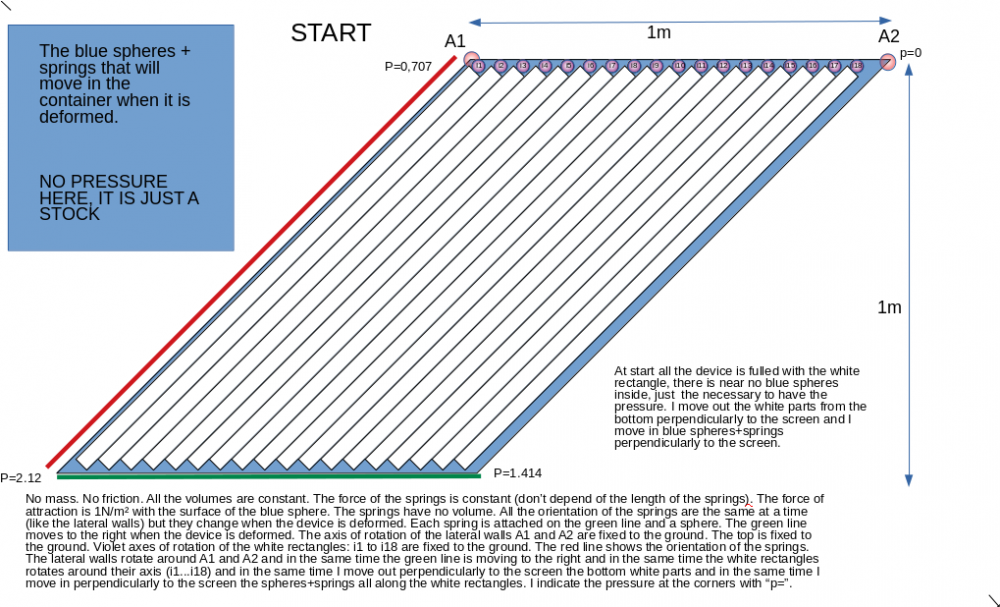

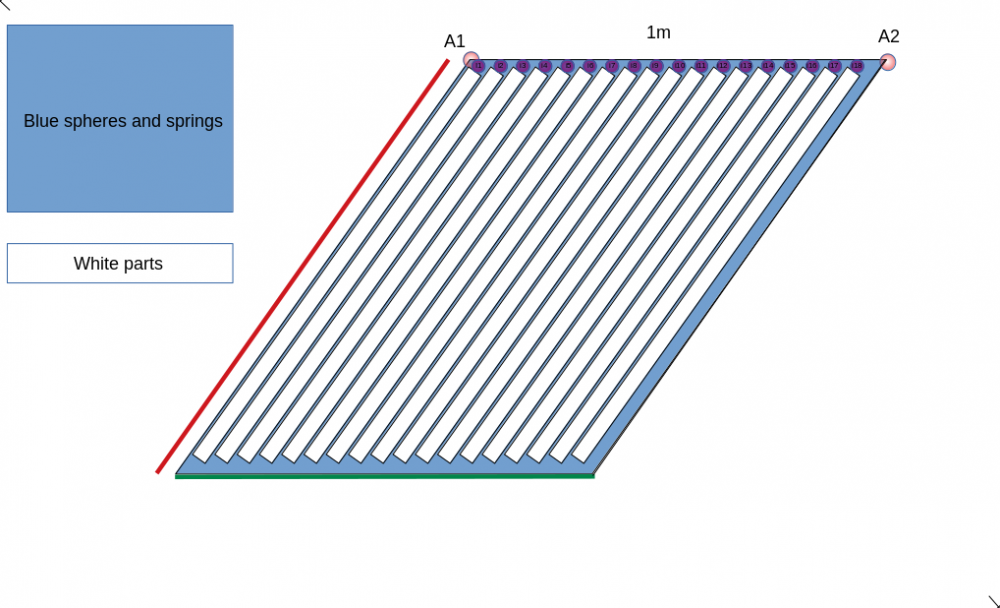
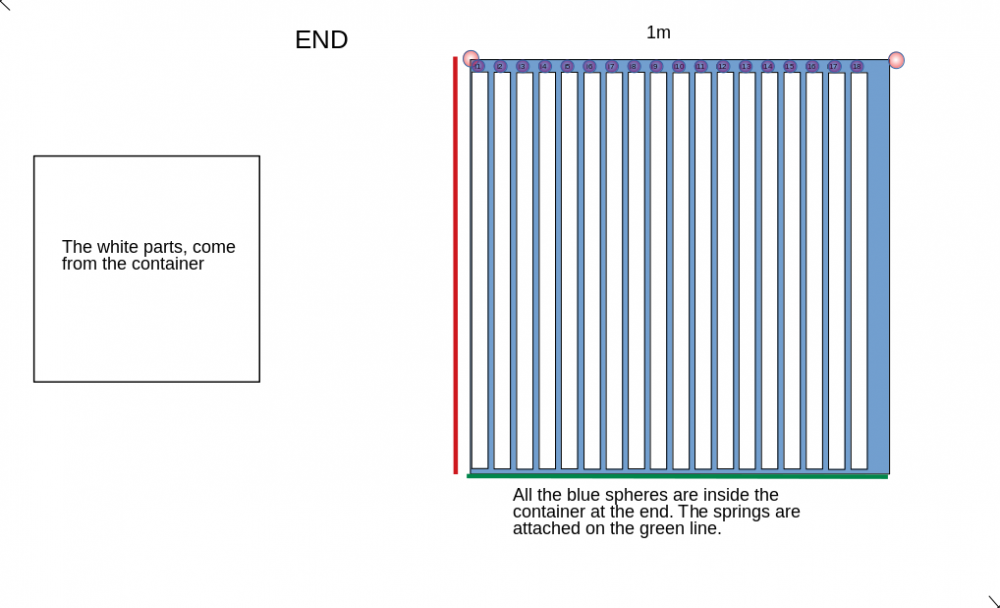
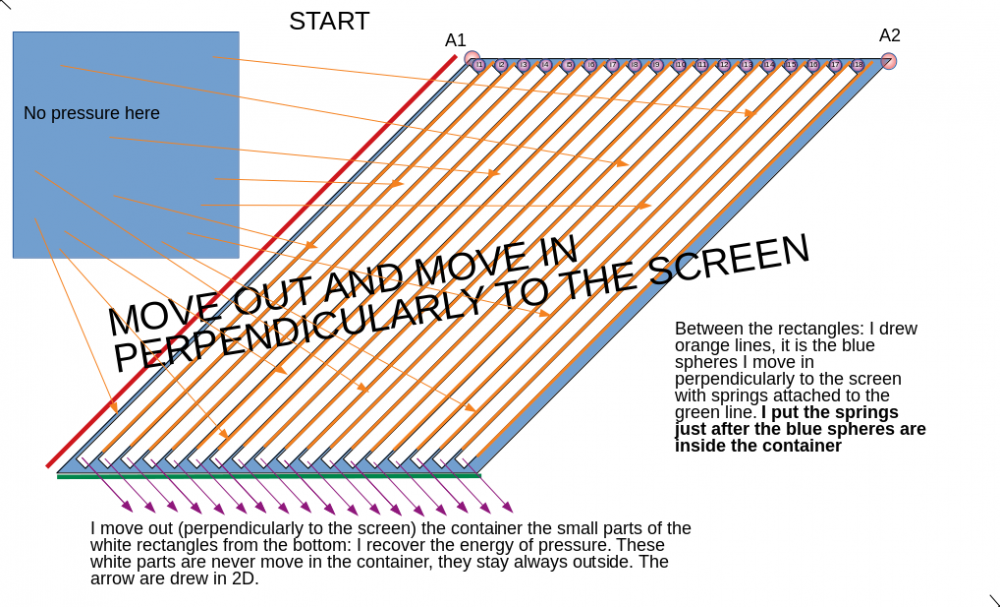
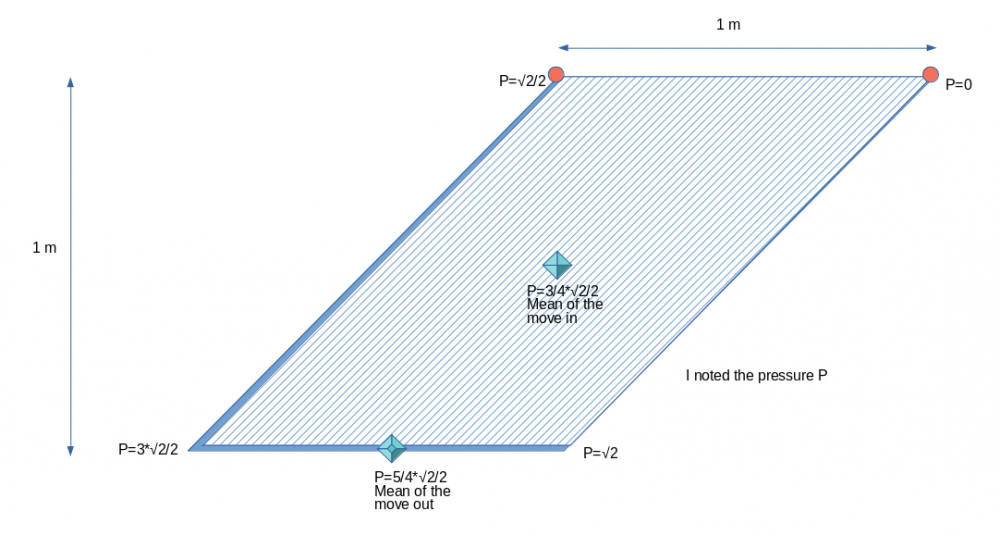
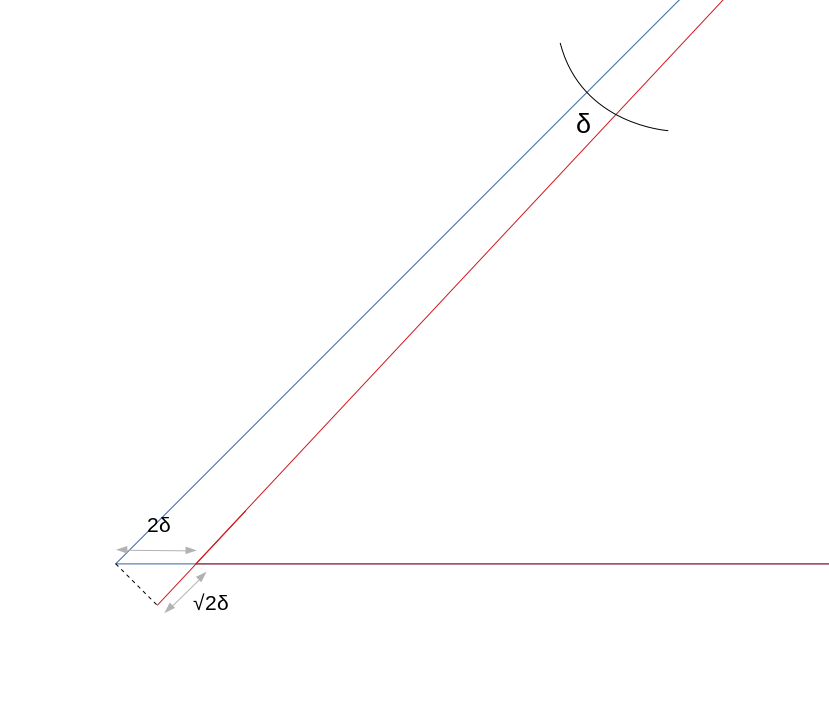
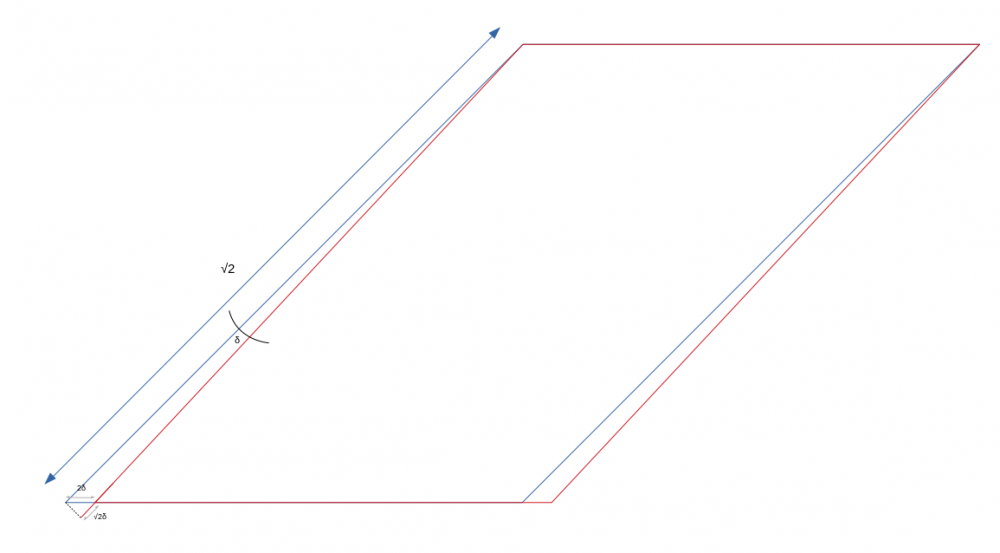



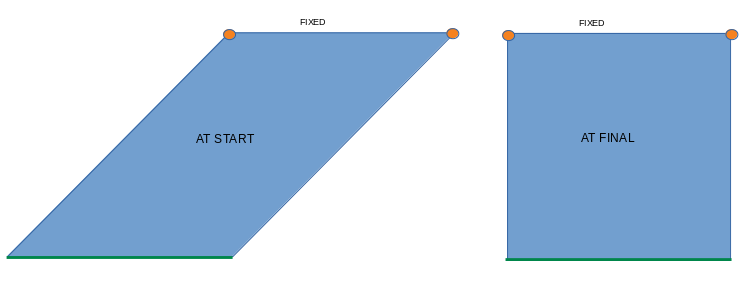







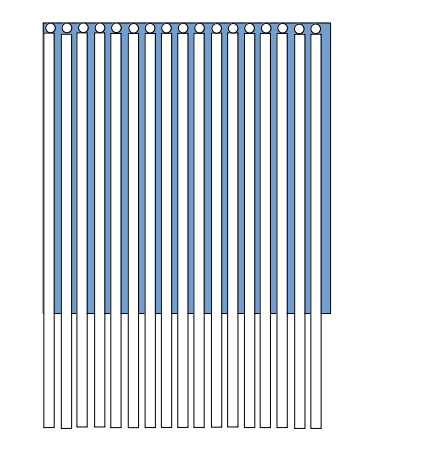


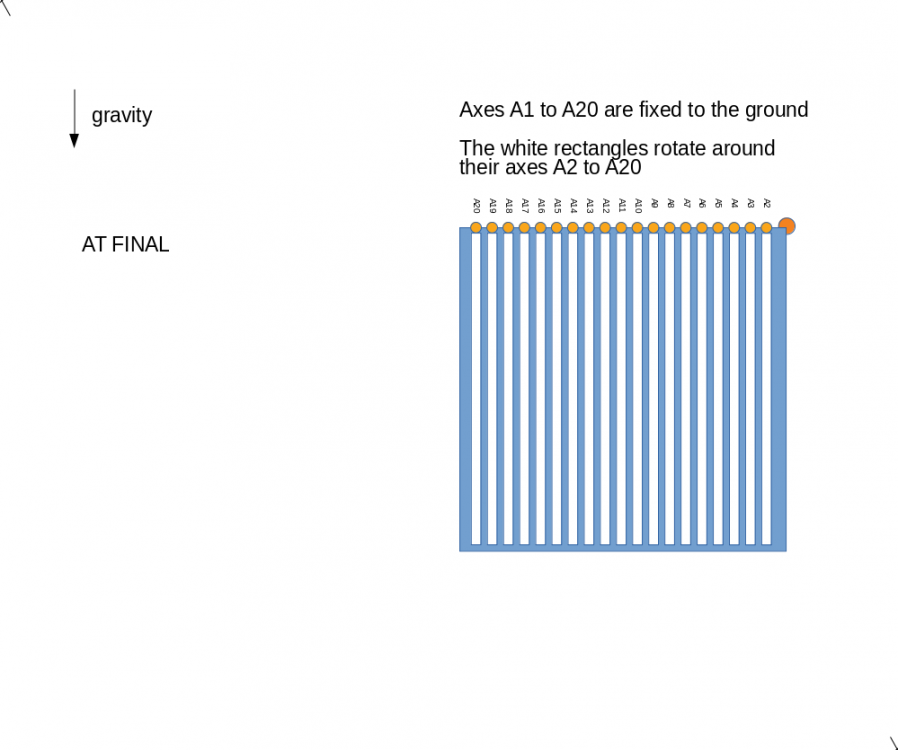

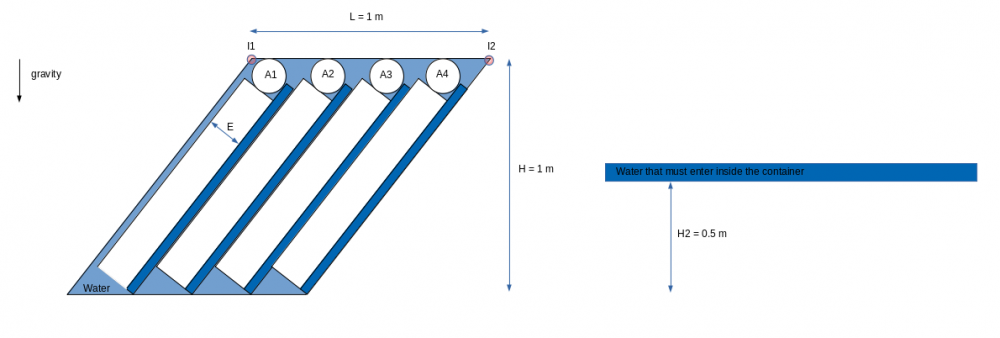
Sum of energy not constant
in Speculations
Posted
Yes, like the animation shows it (the white stockpile increases)
The values of the energies ? It is easy, with the simplifications, I listed all the works:
a/ Rotate the lateral walls
b/ Move out/in
c/ Reduce the length of the springs
d/ Move the green line
I have the force of each spring, so I have the pressure. I gave the force of the spring relative to a volume because like that if I change the volume of the spheres all the calculations are correct. The only thing I didn't take in account it the coefficient of the sphere packing, if I take 0.74, I need to multiply all my calculations with that coef. it doesn't change the problem with the sum of energy and in theory I could fill all the volume with different diameters of the blue spheres.
I have the force of the springs, I have the pressure.